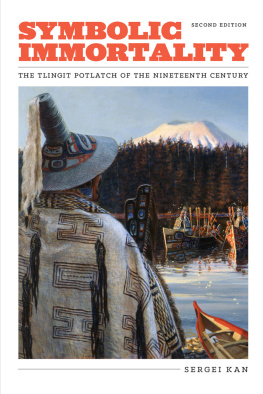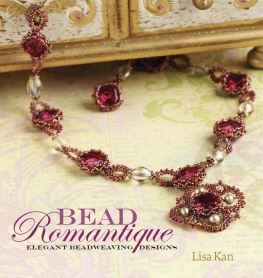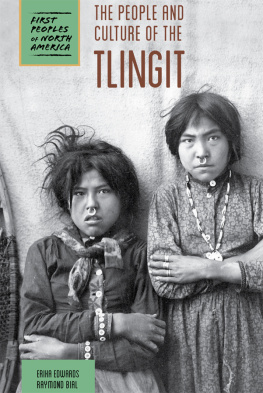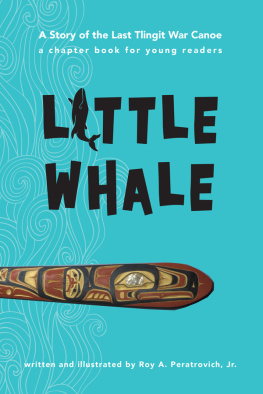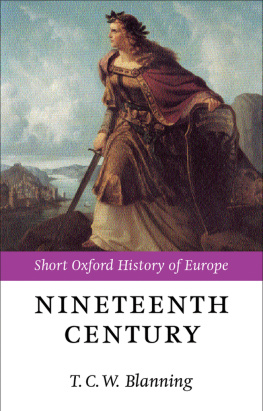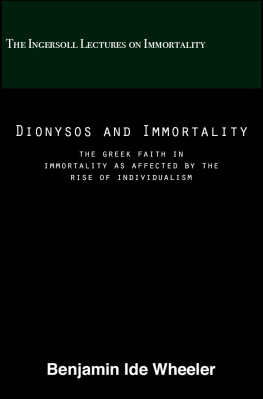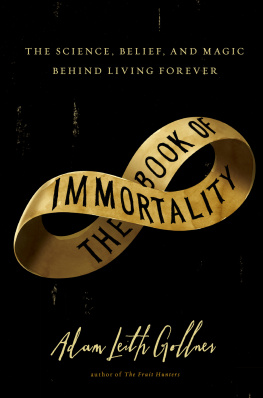Kan - Symbolic immortality: the Tlingit potlatch of the nineteenth century
Here you can read online Kan - Symbolic immortality: the Tlingit potlatch of the nineteenth century full text of the book (entire story) in english for free. Download pdf and epub, get meaning, cover and reviews about this ebook. City: North America;Northwest Coast of North America, year: 2016;2015, publisher: University of Washington Press, genre: Politics. Description of the work, (preface) as well as reviews are available. Best literature library LitArk.com created for fans of good reading and offers a wide selection of genres:
Romance novel
Science fiction
Adventure
Detective
Science
History
Home and family
Prose
Art
Politics
Computer
Non-fiction
Religion
Business
Children
Humor
Choose a favorite category and find really read worthwhile books. Enjoy immersion in the world of imagination, feel the emotions of the characters or learn something new for yourself, make an fascinating discovery.
Symbolic immortality: the Tlingit potlatch of the nineteenth century: summary, description and annotation
We offer to read an annotation, description, summary or preface (depends on what the author of the book "Symbolic immortality: the Tlingit potlatch of the nineteenth century" wrote himself). If you haven't found the necessary information about the book — write in the comments, we will try to find it.
Kan: author's other books
Who wrote Symbolic immortality: the Tlingit potlatch of the nineteenth century? Find out the surname, the name of the author of the book and a list of all author's works by series.
Symbolic immortality: the Tlingit potlatch of the nineteenth century — read online for free the complete book (whole text) full work
Below is the text of the book, divided by pages. System saving the place of the last page read, allows you to conveniently read the book "Symbolic immortality: the Tlingit potlatch of the nineteenth century" online for free, without having to search again every time where you left off. Put a bookmark, and you can go to the page where you finished reading at any time.
Font size:
Interval:
Bookmark:

PRAISE FOR THE FIRST EDITION
WINNER OF THE BEFORE COLUMBUS FOUNDATIONS AMERICAN BOOK AWARD
A sensitive and comprehensive study of the mortuary complex among the Tlingit Indians of southeastern Alaska. This book will become one of the few classics in the literature of the North Pacific Coast.
American Indian Quarterly
Kans work is a welcome addition to literature on the potlatch, and provides fresh insights into traditional Tlingit culture as it survived into the nineteenth century through the window of mortuary rites. Kans work must be recommended for its innovative approaches to the study of the Tlingit and the study of their mortuary rites, which provide much food for thought for comparison with other societies.
Anthropos
Kans presentation of rich and complex data on many aspects of the Tlingit mortuary attests to his sensitivity as a fieldworker (and to the perhaps surprising strength of Tlingit tradition). What is more, Kan is the first to make such extensive use of archival and ethnohistorical sources to present as complete as possible a picture of the nineteenth-century Tlingit potlatch. The book is a welcome addition to the literature on the Northwest Coast, ritual exchange, ethnopsychology, and mortuary practices, and deserves a wide and lasting audience.
Arctic Anthropology
There is a beauty and rhythm to the Tlingit mortuary complex which makes compelling reading. Most simply, this monograph is an anthropological study of death. In their mortuary rites, culminating in the memorial potlatch, the Tlingit transformed death from a threat to the social order into the major opportunity for imposing a sense of order on the flow of social life.
Arctic and Alpine Research
SYMBOLIC IMMORTALITY
SECOND EDITION
SYMBOLIC IMMORTALITY
THE TLINGIT POTLATCH OF THE NINETEENTH CENTURY
SERGEI KAN
University of Washington Press | Seattle and London
Symbolic Immortality is published with the assistance of a grant from the Naomi B. Pascal Editors Endowment, supported through the generosity of Janet and John Creighton, Patti Knowles, Mary McLellan Williams, and other donors.
2016 by the University of Washington Press
Printed and bound in the United States of America
Display face set in Barrel, a typeface designed by Matthew Avery, based on nineteenth-century wood typefaces
Text face composed in Charis SIL, a typeface designed by SIL Internaional, based on Matthew Carters Bitstream Charter typeface
19 18 17 16 5 4 3 2 1
All rights reserved. No part of this publication may be reproduced or transmitted in any form or by any means, electronic or mechanical, including photocopy, recording, or any information storage or retrieval system, without permission in writing from the publisher.
University of Washington Press
www.washington.edu/uwpress
Library of Congress Cataloging-in-Publication Data
Kan, Sergei.
Symbolic immortality : the Tlingit potlatch of the nineteenth century / Sergei Kan. Second edition.
p. cm.
Includes bibliographical references and index.
ISBN 978-0-295-99514-4 (hardcover : alk. paper) ISBN 978-0-295-99489-5 (pbk. : alk. paper)
1. Tlingit IndiansFuneral customs and rites. 2. PotlatchNorthwest Coast of North America. 3. Indians of North AmericaFuneral customs and ritesNorthwest Coast of North America. I. Title. II. Title: Tlingit potlatch of the nineteenth century.
E99.T6K34 2015
979.8004'9727dc23
2015012081
The paper used in this publication is acid-free and meets the minimum requirements of American National Standard for Information SciencesPermanence of Paper for Printed Library Materials, ANSI Z39.481984.
To Alla with love and gratitude
Youhanded me my life, as from a book shelf, blowing off the dust.
Boris Pasternak, From Superstition
(translated by Richard Dauenhauer)
And to Richard Dauenhauer (19422014)
Memory Eternal! B eHa aMT!
Contents
Preface to the Second Edition
Several reasons exist for my decision to produce a revised and expanded second edition of Symbolic Immortality. Originally published twenty-five years ago and out of print for the last fifteen, the book nevertheless continues to be used in both undergraduate and graduate courses and has become a standard work in Northwest Coast and Alaska Native ethnology. Over the years, a number of colleagues have encouraged me to make this book available once again.
Moreover, since the books original publication, I have been privileged to attend a dozen additional memorial potlatches, not only in Sitka but in Angoon and Juneau as well, increasing my data on and understanding of this ceremony, and several major works on this subject have appeared since 1989. The fact that Tlingit (or non-Tlingit working very closely with the Tlingit community) are the authors of most of them makes these works particularly valuable (see Dauenhauer and Dauenhauer 1990; R. Dauenhauer 2000; White and White 2000; Jacobs n.d.a.). Data from these works as well as my own post-1989 findings have informed modifications and corrections in the material presented in this new edition.
Finally, drawing on the work I have carried out since the original publication of Symbolic Immortality as well as in response to suggestions by several of the books reviewers, I have added an epilogue to this edition that provides a brief overview of continuity and change in the Tlingit mortuary and memorial complex and especially the memorial potlatch ( k oo.ex) since the late nineteenth century (see Kan 1989, 1999, 2000, 2003, 2005;
Harkin 1996).
Acknowledgments
My initial interest in native North Americans developed during my undergraduate years at Boston University, where I had the privilege of studying with Dennis Tedlock and the late Eva Hunt. As a graduate student in anthropology at the University of Chicago, I developed a theoretical agenda and narrowed my areal interests to Southeast Alaska, under the guidance of several scholars, particularly Nancy Munn, George W. Stocking, Jr., Jean Comaroff, and John Comaroff. Their comments on my early work helped transform it into the present study. My principal mentor and good friend Raymond D. Fogelson deserves special credit for being so generous with his time and sharing his ideas and books from his library.
My initial publication, which I have thoroughly revised and expanded for this book, was based on thirteen months of ethnographic and historical research conducted among the Tlingit of Alaska in 1979 and 1980 and subsequent research in several libraries and archives. Since the completion of my research in 1982 and the publication of the first edition of this book in 1989, I have returned to Southeast Alaska every other year in the 1980s and 1990s and annually in more recent years, and have corresponded regularly with several friends and key consultants. On several occasions I flew to Southeast Alaska for the sole purpose of attending a memorial potlatch, either as a guest or as a member of the house, clan, or moiety of the hosts. All in all, between 1980 and 2007, I attended thirteen of these ceremonies in three Tlingit communities, collecting a great deal of data.
The focus of my initial fieldwork was on the northern Tlingit, with much of my time spent in Sitka. I also spent three months in Angoon and two in Juneau, and I made two visits to Hoonah and one to Kake. In Sitka I also was able to work with mostly elderly consultants from several major Tlingit communities to the north and south.
Of all the Tlingit friends and teachers who had shared their knowledge and opened their homes to me, a special word of thanks must be given to Mark Jacobs, Jr. (19232005), who in the early 1990s adopted me into his Daklaweid clan and Killer Whale house and bestowed on me the name ( G unakw) of his late brother Ernest. An extremely knowledgeable native historian and a wonderful human being, Mark taught me a great deal about his peoples culture and history. Conversations with Mark as well as his detailed letters were the lifeline that for twenty-five years linked me to the Tlingit community (Kan 2001, 2015). Marks son, Harold Jacobs, has also been a major source of valuable ethnographic information, as well as a good friend.
Next pageFont size:
Interval:
Bookmark:
Similar books «Symbolic immortality: the Tlingit potlatch of the nineteenth century»
Look at similar books to Symbolic immortality: the Tlingit potlatch of the nineteenth century. We have selected literature similar in name and meaning in the hope of providing readers with more options to find new, interesting, not yet read works.
Discussion, reviews of the book Symbolic immortality: the Tlingit potlatch of the nineteenth century and just readers' own opinions. Leave your comments, write what you think about the work, its meaning or the main characters. Specify what exactly you liked and what you didn't like, and why you think so.

